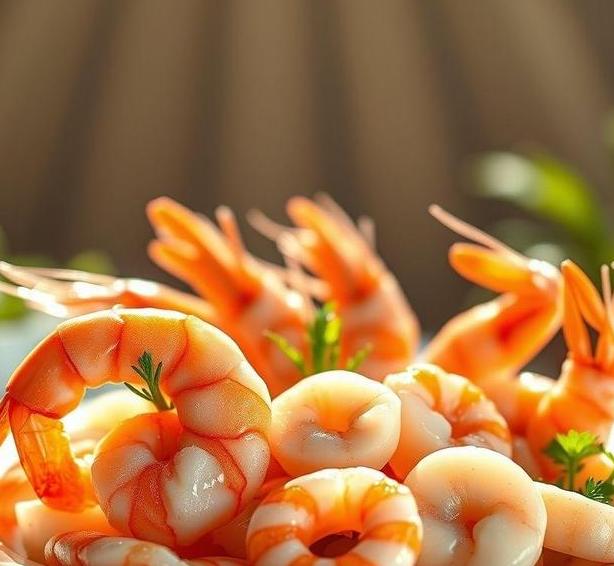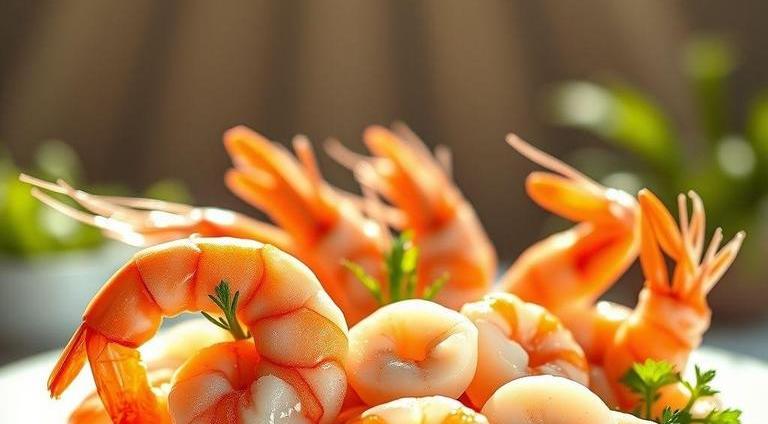Shrimp and scallops are among the most popular seafood items, often found in seafood platters, pasta dishes, and a variety of cuisines around the world. Both are prized for their delicate flavor, firm texture, and versatility in cooking. However, like all fresh seafood, they are highly perishable, which raises an important question for home cooks: Can shrimp and scallops go bad? Understanding the shelf life, signs of spoilage, and proper storage methods is crucial to not only ensure the quality of your meal but also to avoid potential health risks.
In this guide, we’ll dive into everything you need to know about how shrimp and scallops can spoil, how long they last, and the best practices for storing them to maintain freshness.
Can Shrimp And Scallops Go Bad?
Yes, both shrimp and scallops can go bad. In fact, like most seafood, they are highly susceptible to spoiling because of their delicate nature. The exact rate at which they spoil depends on factors such as the type of shrimp or scallop, their initial freshness when purchased, and how they are stored. Spoiled seafood can not only lose its flavor and texture but can also become a breeding ground for harmful bacteria that can lead to food poisoning.
Here are a few important things to remember:
- Shrimp: When shrimp is fresh, it has a slightly sweet, clean smell and a firm texture. However, if it starts to deteriorate, it will develop a sour or ammonia-like odor. Shrimp are highly vulnerable to bacterial growth if not stored properly, and their short shelf life means they can go bad faster than you might think.
- Scallops: Fresh scallops have a mild, oceanic scent and should feel firm to the touch. If scallops are allowed to sit too long, they’ll start to smell strong and fishy, indicating they’ve gone off. When this happens, they not only lose their flavor but also their texture, becoming soft and mushy.
Shelf Life For Shrimp And Scallops

Understanding how long shrimp and scallops last is key to preventing waste and ensuring you always enjoy them at their freshest. The shelf life of shrimp and scallops depends largely on how they are stored, whether they are cooked or raw, and whether they are fresh or frozen.
Fresh Shrimp And Scallops
- Raw shrimp: Fresh, raw shrimp should be cooked or frozen within one to two days of purchase. After that, they can spoil rapidly, even when kept in the fridge.
- Raw scallops: Similarly, fresh raw scallops should be consumed within one to two days, as they are even more delicate than shrimp and spoil faster.
Frozen Shrimp And Scallops
- Frozen shrimp: When properly stored in a freezer, frozen shrimp can last anywhere from six months to a year. However, the quality (taste and texture) will begin to degrade the longer it is kept frozen.
- Frozen scallops: Frozen scallops can last up to 6 months in the freezer, though, like shrimp, their quality will suffer over time. Proper packaging (vacuum-sealed or tightly wrapped) helps prevent freezer burn and maintain their texture.
Cooked Shrimp And Scallops
- Cooked shrimp: Cooked shrimp should be eaten within 3 days if stored in the fridge. After that, they risk developing an off taste or texture, and bacteria can grow.
- Cooked scallops: Similar to cooked shrimp, scallops should be stored in the fridge and eaten within 2-3 days to preserve flavor and safety.
Common Signs Of Spoilage
It’s important to be able to recognize when shrimp or scallops have gone bad. Spoiled seafood often gives off noticeable signals that indicate it should not be consumed. Here’s a detailed list of the common signs of spoilage:
Unpleasant Odor
- Fresh shrimp and scallops should smell clean and slightly sweet, with a mild oceanic scent. If the seafood gives off a strong fishy or ammonia-like smell, it has likely spoiled and should be discarded.
Slimy Or Sticky Texture
- Fresh shrimp and scallops have a firm, slightly springy texture. If the flesh feels slimy, sticky, or mushy, it’s a sign that bacteria have started to break down the proteins in the seafood.
Discoloration
- Shrimp: Fresh shrimp should be translucent or slightly pink. If the shrimp are turning gray, dark, or have developed black spots, they have started to spoil.
- Scallops: Fresh scallops should be pearly white with a firm texture. If they develop a yellowish or off-white color, it’s a sign they’ve gone bad.
Off Taste
- If you taste shrimp or scallops that seem off in any way-whether they’re too sour, bitter, or just have an unpleasant, unnatural flavor-they should not be consumed. Always trust your taste buds if you’re unsure.
Softness Or Mushiness
- Fresh scallops, in particular, should be firm and slightly springy to the touch. If they’re overly soft or mushy, it indicates they’ve broken down and gone bad. This is especially true for scallops that are not frozen and kept for a long period.
How To Store Shrimp And Scallops?

Proper storage is the most effective way to extend the shelf life of shrimp and scallops. If you want to keep them as fresh as possible, follow these tips for the best storage methods:
Refrigeration
-
For Fresh Shrimp & Scallops
- Store them in the coldest part of your refrigerator, ideally on a bed of ice in a shallow pan or dish, covered with plastic wrap. Change the ice regularly to keep the shrimp and scallops at a consistent low temperature.
- If you’ve purchased them in their original packaging, keep them in that packaging. If they’ve been repackaged or opened, place them in an airtight container to prevent exposure to air, which accelerates spoilage.
-
For Cooked Shrimp & Scallops
- Store cooked seafood in an airtight container in the fridge for up to 3 days. Be sure to cool them to room temperature before refrigerating to avoid increasing the temperature inside the fridge.
Freezing
-
For Frozen Shrimp & Scallops
- If you plan to freeze shrimp or scallops, do so immediately after purchase. Shrimp and scallops should be placed in vacuum-sealed bags or wrapped tightly in plastic wrap, followed by foil to prevent freezer burn.
- Label the bags with the date of freezing so you can easily track how long they’ve been in the freezer.
Thawing
- To thaw frozen shrimp and scallops, place them in the fridge for several hours or overnight. If you’re in a rush, you can also defrost them by placing them in a sealed bag under cold running water.
Expert Tips
- Buy Fresh: When purchasing shrimp and scallops, try to buy them on the same day you plan to cook them. The fresher they are, the longer you’ll have to enjoy them.
- Don’t Overcook: Both shrimp and scallops are delicate seafood, and overcooking them can cause them to become rubbery and tough. Cook them only until they turn opaque and firm up.
- Smell Test: Always use your sense of smell before cooking. If it doesn’t smell fresh, don’t risk eating it. Trust your nose!
- Frozen is Fine: While fresh is always best, frozen shrimp and scallops are often just as good when properly frozen. Many shrimp and scallops are frozen right after being caught, so they can be just as fresh as those that were never frozen.
FAQs
Can Shrimp And Scallops Go Bad In The Fridge?
Yes, both shrimp and scallops can go bad in the fridge. Fresh shrimp and scallops should be consumed within 1-2 days of purchase if stored properly at temperatures below 40°F (4°C). If left longer, they will spoil, develop an off odor, and show signs of sliminess.
How Can You Tell If Shrimp Or Scallops Have Gone Bad?
Shrimp and scallops that have gone bad typically exhibit a strong, sour, or ammonia-like odor. The flesh may appear discolored or have an off-putting slimy texture. Additionally, spoiled shrimp will often appear mushy when touched, and scallops may lose their firm texture.
How Long Can Shrimp And Scallops Stay In The Freezer?
Shrimp and scallops can last 6-12 months in the freezer if stored properly in airtight packaging. Over time, they may lose flavor and texture, but they should still be safe to eat if kept at a consistent freezing temperature.
Can Shrimp And Scallops Go Bad After Being Frozen?
While freezing shrimp and scallops helps extend their shelf life, they can still go bad if they are thawed and refrozen multiple times. Additionally, freezer burn can occur, leading to changes in texture and taste, though they remain safe to eat.
What Is The Shelf Life Of Cooked Shrimp And Scallops?
Cooked shrimp and scallops can last 3-4 days in the refrigerator when stored in an airtight container. They should be consumed promptly after cooking to avoid bacterial growth and spoilage.
Is It Safe To Eat Shrimp And Scallops If They Have Been Sitting Out Overnight?
No, it is not safe to eat shrimp and scallops if they have been left at room temperature for more than two hours. Bacteria multiply rapidly at temperatures above 40°F (4°C), increasing the risk of foodborne illness.
How Should I Store Shrimp And Scallops To Prevent Spoilage?
Shrimp and scallops should be stored in the coldest part of the fridge, ideally in a shallow dish or container covered with ice to keep them at a safe temperature. They can also be vacuum-sealed for longer storage. If freezing, use airtight bags or containers to prevent freezer burn.
Can Shrimp And Scallops Spoil If They Are Improperly Handled During Purchase?
Yes, shrimp and scallops can spoil if they are not handled properly during purchase. Make sure to buy them from a reputable source and check their freshness before buying. Keep them cold from the store to your home and refrigerate them promptly.
Can I Eat Shrimp Or Scallops If They Smell Like Ammonia?
No, shrimp or scallops with an ammonia-like smell are not safe to eat. This odor is a sign of spoilage and can indicate the presence of harmful bacteria. Consuming spoiled seafood can lead to food poisoning.
Can You Still Cook Shrimp And Scallops If They Are Slightly Slimy?
If shrimp or scallops are slightly slimy but do not have an off odor or significant discoloration, they may still be safe to cook, but it’s best to err on the side of caution. If they exhibit any signs of spoilage, it’s safer to discard them to avoid potential foodborne illness.